Nursing Complex Care Report: Identifying and Prioritizing Issues
VerifiedAdded on 2022/10/11
|9
|1944
|10
Report
AI Summary
This report examines a nursing case study involving a 69-year-old male patient admitted with respiratory issues, including a productive cough and shortness of breath. The report identifies and prioritizes key patient health issues such as ineffective airway clearance, impaired gas exchange, and alcohol withdrawal, supported by relevant literature. It provides detailed rationales for prioritizing these issues within the scope of nursing practice. Furthermore, the report outlines the nurse's role, discussing regulatory frameworks and health department policies relevant to the case, including medication safety, infection control, and therapeutic patient relationships. The framework of nursing care, including assessment, intervention, and evaluation, is discussed within the context of a one-month care plan, emphasizing the importance of providing timely medication, oxygen therapy, and patient education to improve both the mental and physical health conditions.
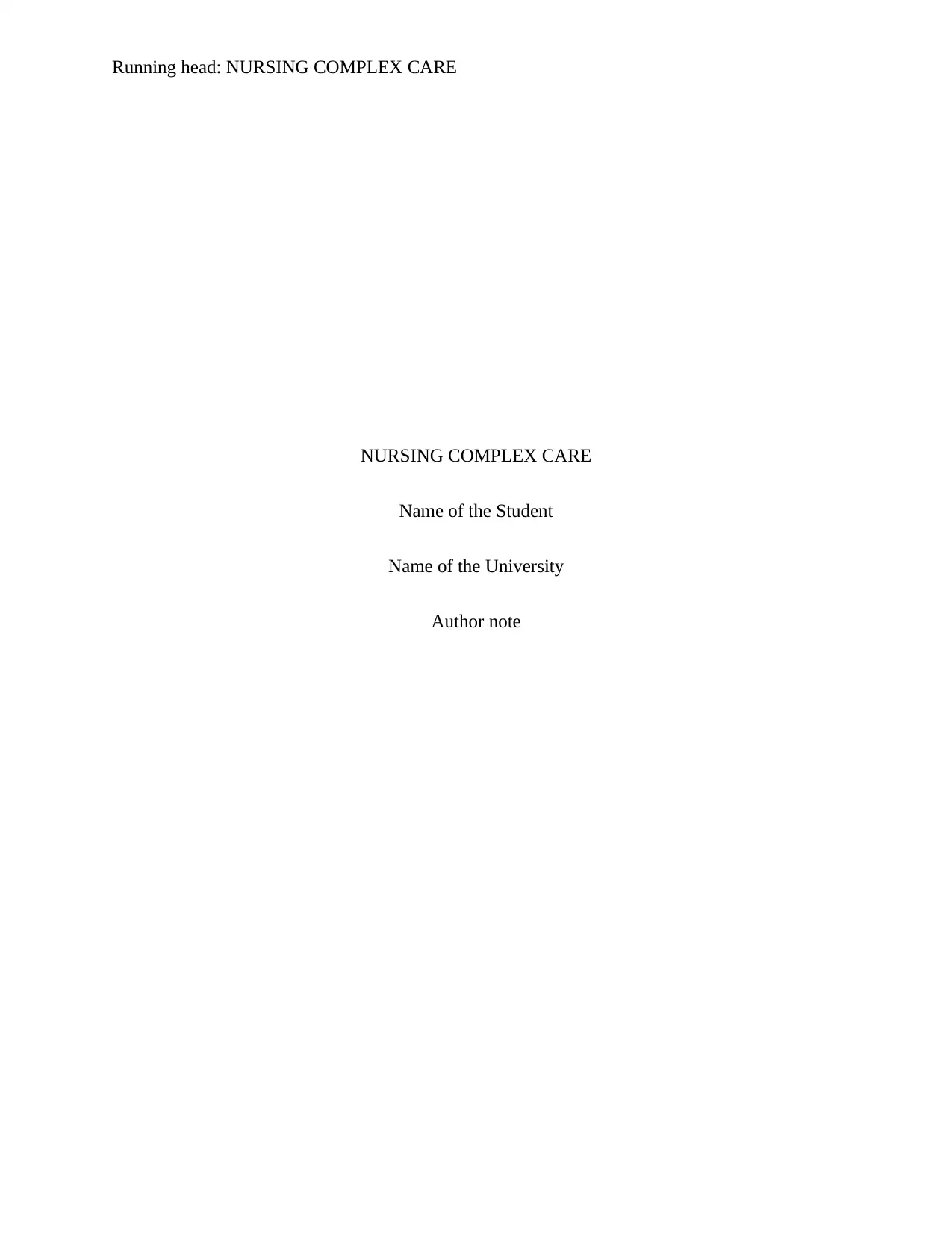
Running head: NURSING COMPLEX CARE
NURSING COMPLEX CARE
Name of the Student
Name of the University
Author note
NURSING COMPLEX CARE
Name of the Student
Name of the University
Author note
Paraphrase This Document
Need a fresh take? Get an instant paraphrase of this document with our AI Paraphraser
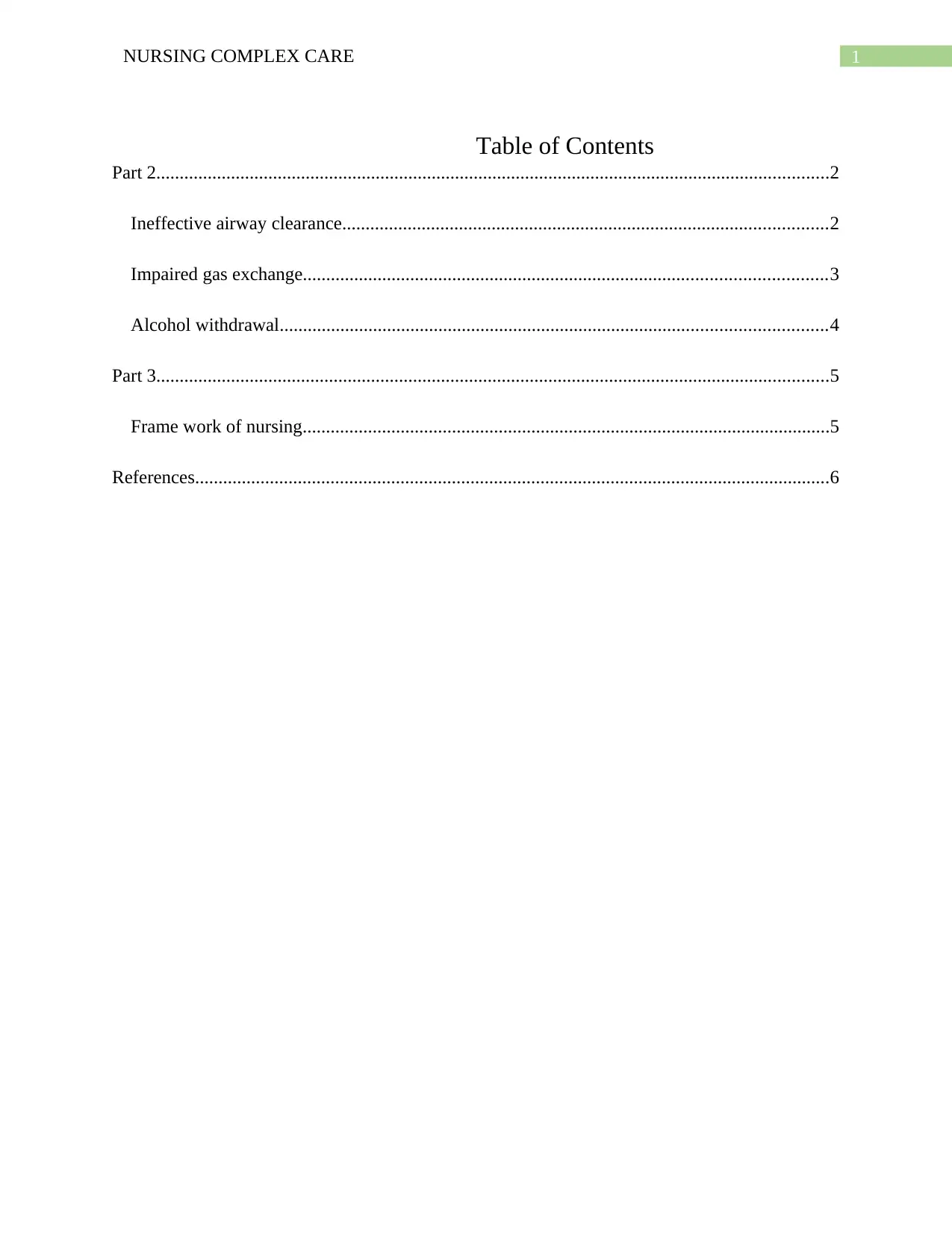
1NURSING COMPLEX CARE
Table of Contents
Part 2................................................................................................................................................2
Ineffective airway clearance........................................................................................................2
Impaired gas exchange................................................................................................................3
Alcohol withdrawal.....................................................................................................................4
Part 3................................................................................................................................................5
Frame work of nursing.................................................................................................................5
References........................................................................................................................................6
Table of Contents
Part 2................................................................................................................................................2
Ineffective airway clearance........................................................................................................2
Impaired gas exchange................................................................................................................3
Alcohol withdrawal.....................................................................................................................4
Part 3................................................................................................................................................5
Frame work of nursing.................................................................................................................5
References........................................................................................................................................6
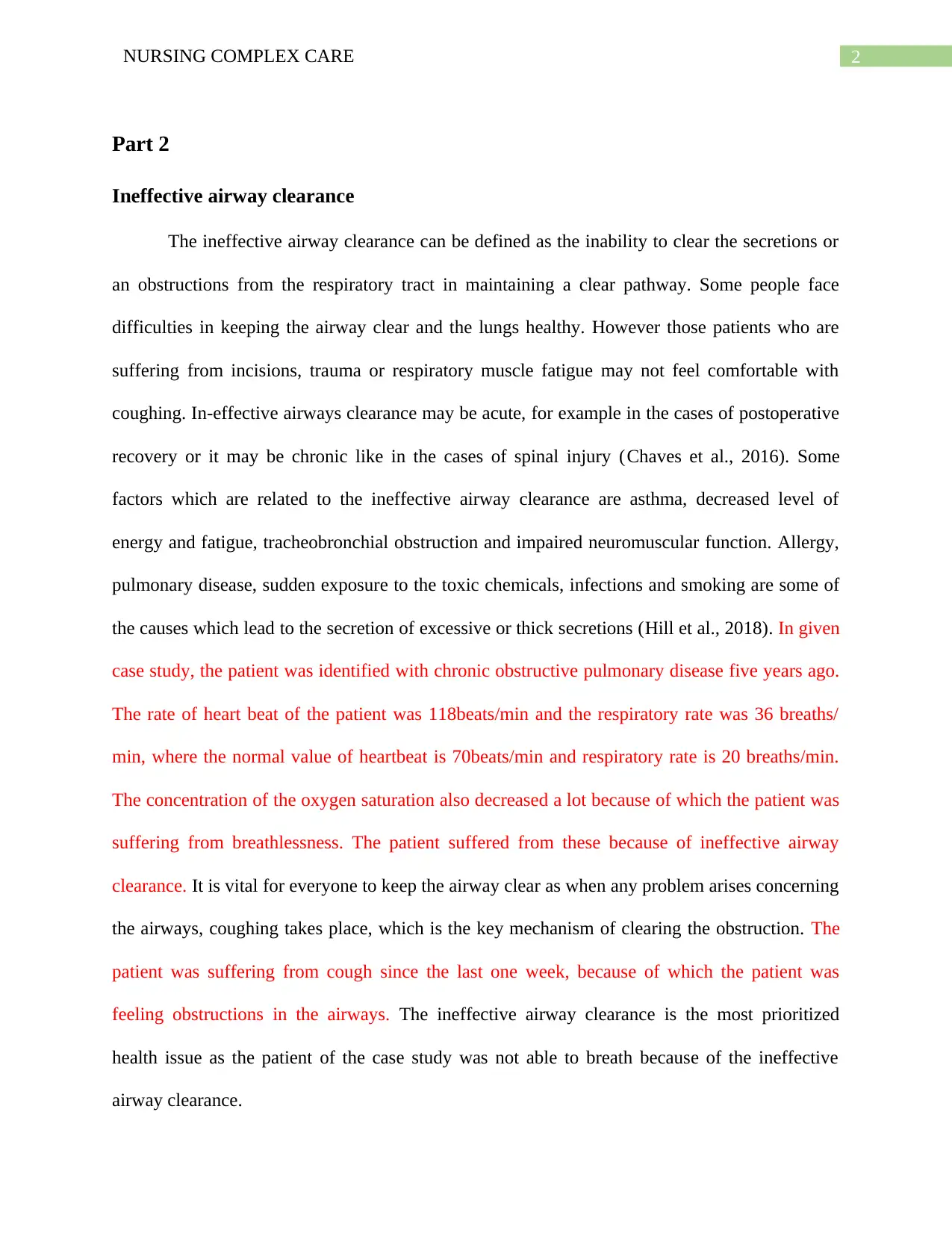
2NURSING COMPLEX CARE
Part 2
Ineffective airway clearance
The ineffective airway clearance can be defined as the inability to clear the secretions or
an obstructions from the respiratory tract in maintaining a clear pathway. Some people face
difficulties in keeping the airway clear and the lungs healthy. However those patients who are
suffering from incisions, trauma or respiratory muscle fatigue may not feel comfortable with
coughing. In-effective airways clearance may be acute, for example in the cases of postoperative
recovery or it may be chronic like in the cases of spinal injury (Chaves et al., 2016). Some
factors which are related to the ineffective airway clearance are asthma, decreased level of
energy and fatigue, tracheobronchial obstruction and impaired neuromuscular function. Allergy,
pulmonary disease, sudden exposure to the toxic chemicals, infections and smoking are some of
the causes which lead to the secretion of excessive or thick secretions (Hill et al., 2018). In given
case study, the patient was identified with chronic obstructive pulmonary disease five years ago.
The rate of heart beat of the patient was 118beats/min and the respiratory rate was 36 breaths/
min, where the normal value of heartbeat is 70beats/min and respiratory rate is 20 breaths/min.
The concentration of the oxygen saturation also decreased a lot because of which the patient was
suffering from breathlessness. The patient suffered from these because of ineffective airway
clearance. It is vital for everyone to keep the airway clear as when any problem arises concerning
the airways, coughing takes place, which is the key mechanism of clearing the obstruction. The
patient was suffering from cough since the last one week, because of which the patient was
feeling obstructions in the airways. The ineffective airway clearance is the most prioritized
health issue as the patient of the case study was not able to breath because of the ineffective
airway clearance.
Part 2
Ineffective airway clearance
The ineffective airway clearance can be defined as the inability to clear the secretions or
an obstructions from the respiratory tract in maintaining a clear pathway. Some people face
difficulties in keeping the airway clear and the lungs healthy. However those patients who are
suffering from incisions, trauma or respiratory muscle fatigue may not feel comfortable with
coughing. In-effective airways clearance may be acute, for example in the cases of postoperative
recovery or it may be chronic like in the cases of spinal injury (Chaves et al., 2016). Some
factors which are related to the ineffective airway clearance are asthma, decreased level of
energy and fatigue, tracheobronchial obstruction and impaired neuromuscular function. Allergy,
pulmonary disease, sudden exposure to the toxic chemicals, infections and smoking are some of
the causes which lead to the secretion of excessive or thick secretions (Hill et al., 2018). In given
case study, the patient was identified with chronic obstructive pulmonary disease five years ago.
The rate of heart beat of the patient was 118beats/min and the respiratory rate was 36 breaths/
min, where the normal value of heartbeat is 70beats/min and respiratory rate is 20 breaths/min.
The concentration of the oxygen saturation also decreased a lot because of which the patient was
suffering from breathlessness. The patient suffered from these because of ineffective airway
clearance. It is vital for everyone to keep the airway clear as when any problem arises concerning
the airways, coughing takes place, which is the key mechanism of clearing the obstruction. The
patient was suffering from cough since the last one week, because of which the patient was
feeling obstructions in the airways. The ineffective airway clearance is the most prioritized
health issue as the patient of the case study was not able to breath because of the ineffective
airway clearance.
⊘ This is a preview!⊘
Do you want full access?
Subscribe today to unlock all pages.

Trusted by 1+ million students worldwide
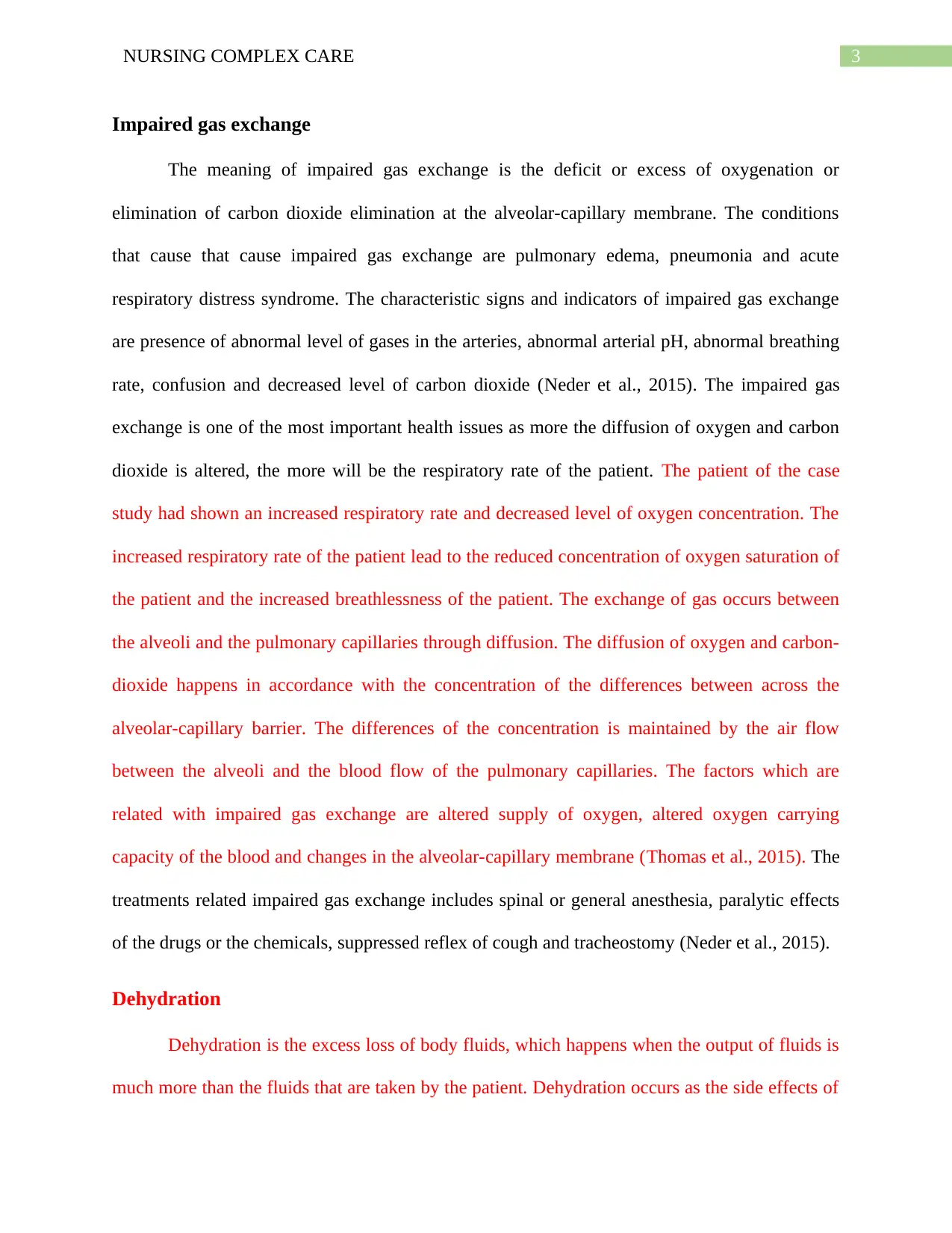
3NURSING COMPLEX CARE
Impaired gas exchange
The meaning of impaired gas exchange is the deficit or excess of oxygenation or
elimination of carbon dioxide elimination at the alveolar-capillary membrane. The conditions
that cause that cause impaired gas exchange are pulmonary edema, pneumonia and acute
respiratory distress syndrome. The characteristic signs and indicators of impaired gas exchange
are presence of abnormal level of gases in the arteries, abnormal arterial pH, abnormal breathing
rate, confusion and decreased level of carbon dioxide (Neder et al., 2015). The impaired gas
exchange is one of the most important health issues as more the diffusion of oxygen and carbon
dioxide is altered, the more will be the respiratory rate of the patient. The patient of the case
study had shown an increased respiratory rate and decreased level of oxygen concentration. The
increased respiratory rate of the patient lead to the reduced concentration of oxygen saturation of
the patient and the increased breathlessness of the patient. The exchange of gas occurs between
the alveoli and the pulmonary capillaries through diffusion. The diffusion of oxygen and carbon-
dioxide happens in accordance with the concentration of the differences between across the
alveolar-capillary barrier. The differences of the concentration is maintained by the air flow
between the alveoli and the blood flow of the pulmonary capillaries. The factors which are
related with impaired gas exchange are altered supply of oxygen, altered oxygen carrying
capacity of the blood and changes in the alveolar-capillary membrane (Thomas et al., 2015). The
treatments related impaired gas exchange includes spinal or general anesthesia, paralytic effects
of the drugs or the chemicals, suppressed reflex of cough and tracheostomy (Neder et al., 2015).
Dehydration
Dehydration is the excess loss of body fluids, which happens when the output of fluids is
much more than the fluids that are taken by the patient. Dehydration occurs as the side effects of
Impaired gas exchange
The meaning of impaired gas exchange is the deficit or excess of oxygenation or
elimination of carbon dioxide elimination at the alveolar-capillary membrane. The conditions
that cause that cause impaired gas exchange are pulmonary edema, pneumonia and acute
respiratory distress syndrome. The characteristic signs and indicators of impaired gas exchange
are presence of abnormal level of gases in the arteries, abnormal arterial pH, abnormal breathing
rate, confusion and decreased level of carbon dioxide (Neder et al., 2015). The impaired gas
exchange is one of the most important health issues as more the diffusion of oxygen and carbon
dioxide is altered, the more will be the respiratory rate of the patient. The patient of the case
study had shown an increased respiratory rate and decreased level of oxygen concentration. The
increased respiratory rate of the patient lead to the reduced concentration of oxygen saturation of
the patient and the increased breathlessness of the patient. The exchange of gas occurs between
the alveoli and the pulmonary capillaries through diffusion. The diffusion of oxygen and carbon-
dioxide happens in accordance with the concentration of the differences between across the
alveolar-capillary barrier. The differences of the concentration is maintained by the air flow
between the alveoli and the blood flow of the pulmonary capillaries. The factors which are
related with impaired gas exchange are altered supply of oxygen, altered oxygen carrying
capacity of the blood and changes in the alveolar-capillary membrane (Thomas et al., 2015). The
treatments related impaired gas exchange includes spinal or general anesthesia, paralytic effects
of the drugs or the chemicals, suppressed reflex of cough and tracheostomy (Neder et al., 2015).
Dehydration
Dehydration is the excess loss of body fluids, which happens when the output of fluids is
much more than the fluids that are taken by the patient. Dehydration occurs as the side effects of
Paraphrase This Document
Need a fresh take? Get an instant paraphrase of this document with our AI Paraphraser
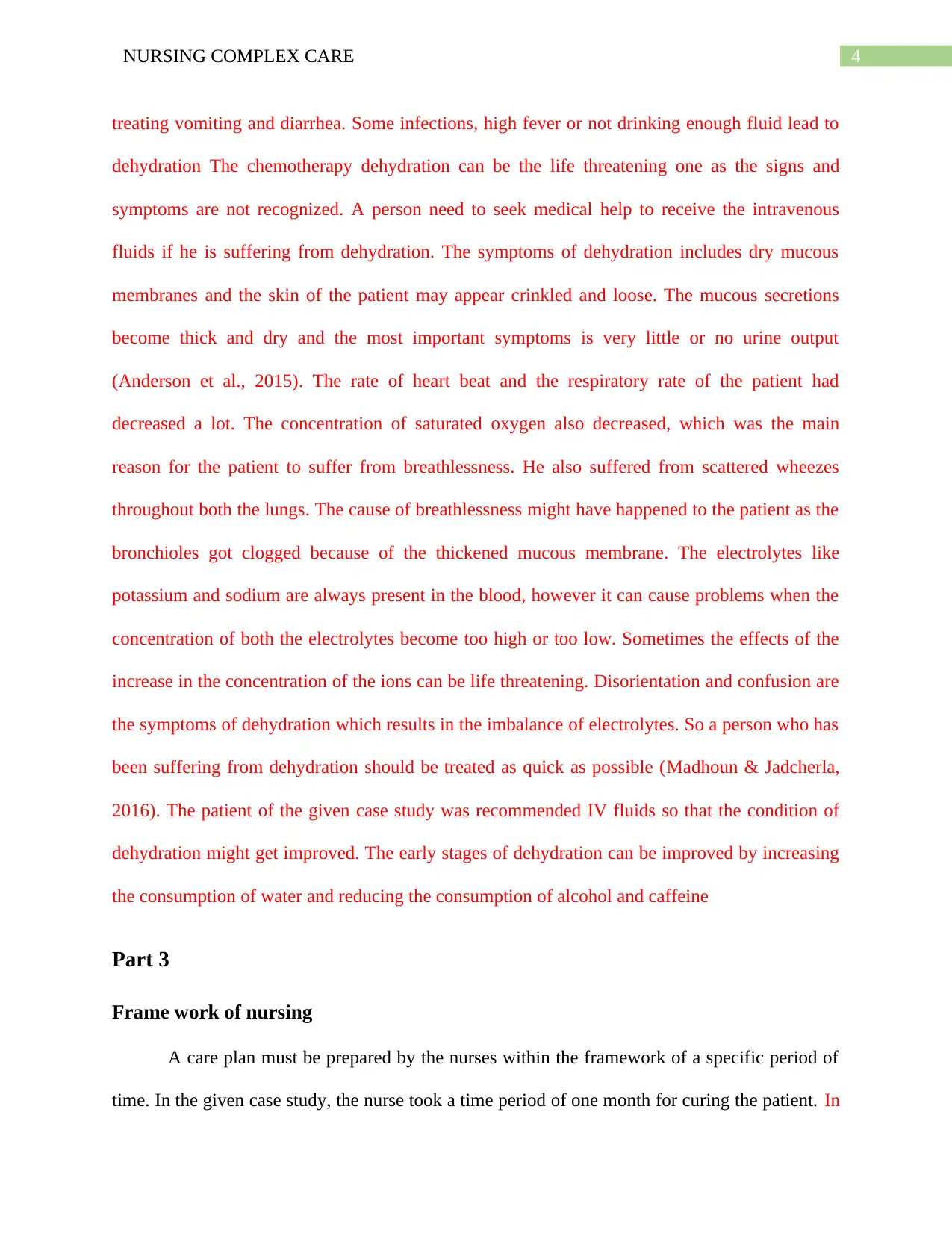
4NURSING COMPLEX CARE
treating vomiting and diarrhea. Some infections, high fever or not drinking enough fluid lead to
dehydration The chemotherapy dehydration can be the life threatening one as the signs and
symptoms are not recognized. A person need to seek medical help to receive the intravenous
fluids if he is suffering from dehydration. The symptoms of dehydration includes dry mucous
membranes and the skin of the patient may appear crinkled and loose. The mucous secretions
become thick and dry and the most important symptoms is very little or no urine output
(Anderson et al., 2015). The rate of heart beat and the respiratory rate of the patient had
decreased a lot. The concentration of saturated oxygen also decreased, which was the main
reason for the patient to suffer from breathlessness. He also suffered from scattered wheezes
throughout both the lungs. The cause of breathlessness might have happened to the patient as the
bronchioles got clogged because of the thickened mucous membrane. The electrolytes like
potassium and sodium are always present in the blood, however it can cause problems when the
concentration of both the electrolytes become too high or too low. Sometimes the effects of the
increase in the concentration of the ions can be life threatening. Disorientation and confusion are
the symptoms of dehydration which results in the imbalance of electrolytes. So a person who has
been suffering from dehydration should be treated as quick as possible (Madhoun & Jadcherla,
2016). The patient of the given case study was recommended IV fluids so that the condition of
dehydration might get improved. The early stages of dehydration can be improved by increasing
the consumption of water and reducing the consumption of alcohol and caffeine
Part 3
Frame work of nursing
A care plan must be prepared by the nurses within the framework of a specific period of
time. In the given case study, the nurse took a time period of one month for curing the patient. In
treating vomiting and diarrhea. Some infections, high fever or not drinking enough fluid lead to
dehydration The chemotherapy dehydration can be the life threatening one as the signs and
symptoms are not recognized. A person need to seek medical help to receive the intravenous
fluids if he is suffering from dehydration. The symptoms of dehydration includes dry mucous
membranes and the skin of the patient may appear crinkled and loose. The mucous secretions
become thick and dry and the most important symptoms is very little or no urine output
(Anderson et al., 2015). The rate of heart beat and the respiratory rate of the patient had
decreased a lot. The concentration of saturated oxygen also decreased, which was the main
reason for the patient to suffer from breathlessness. He also suffered from scattered wheezes
throughout both the lungs. The cause of breathlessness might have happened to the patient as the
bronchioles got clogged because of the thickened mucous membrane. The electrolytes like
potassium and sodium are always present in the blood, however it can cause problems when the
concentration of both the electrolytes become too high or too low. Sometimes the effects of the
increase in the concentration of the ions can be life threatening. Disorientation and confusion are
the symptoms of dehydration which results in the imbalance of electrolytes. So a person who has
been suffering from dehydration should be treated as quick as possible (Madhoun & Jadcherla,
2016). The patient of the given case study was recommended IV fluids so that the condition of
dehydration might get improved. The early stages of dehydration can be improved by increasing
the consumption of water and reducing the consumption of alcohol and caffeine
Part 3
Frame work of nursing
A care plan must be prepared by the nurses within the framework of a specific period of
time. In the given case study, the nurse took a time period of one month for curing the patient. In
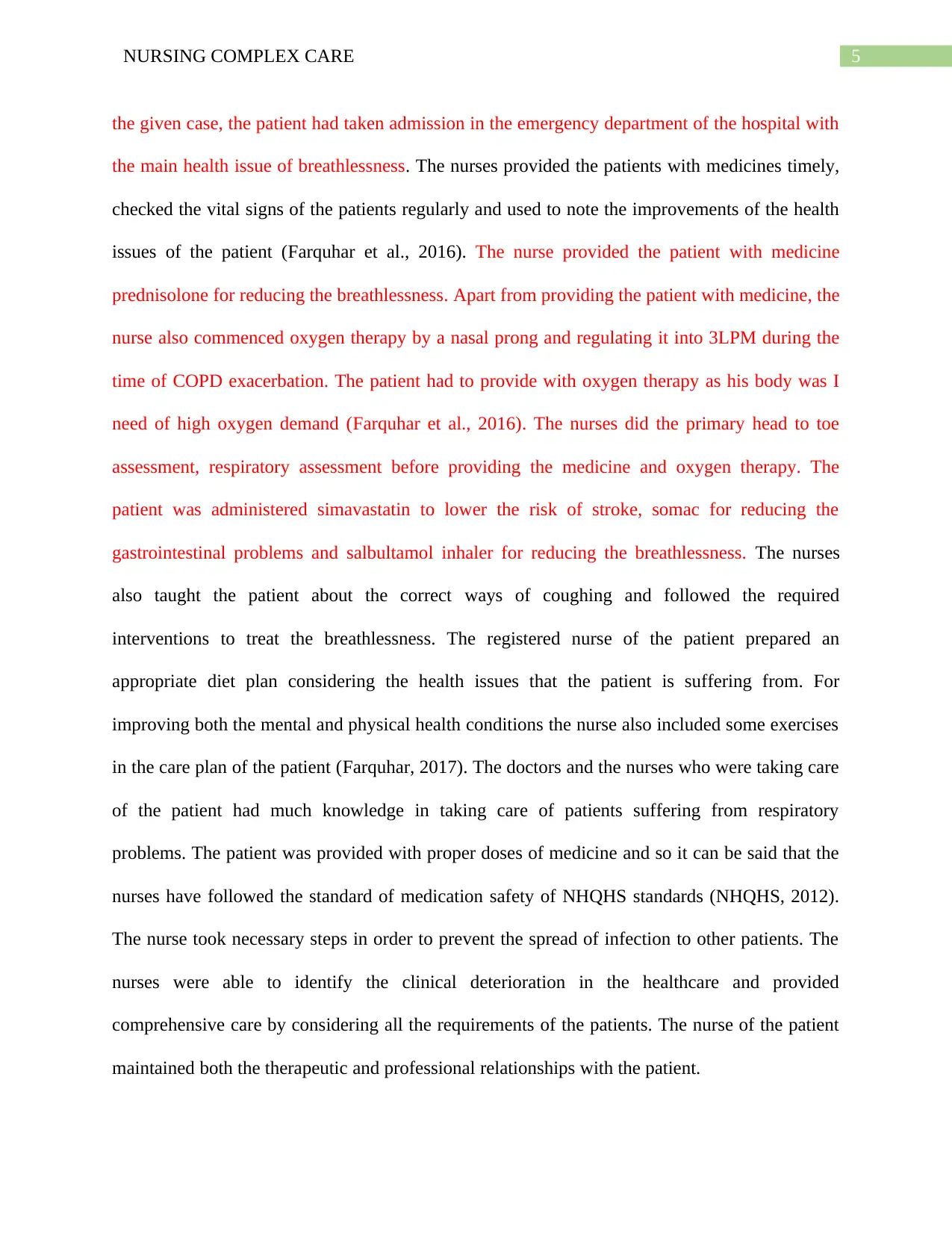
5NURSING COMPLEX CARE
the given case, the patient had taken admission in the emergency department of the hospital with
the main health issue of breathlessness. The nurses provided the patients with medicines timely,
checked the vital signs of the patients regularly and used to note the improvements of the health
issues of the patient (Farquhar et al., 2016). The nurse provided the patient with medicine
prednisolone for reducing the breathlessness. Apart from providing the patient with medicine, the
nurse also commenced oxygen therapy by a nasal prong and regulating it into 3LPM during the
time of COPD exacerbation. The patient had to provide with oxygen therapy as his body was I
need of high oxygen demand (Farquhar et al., 2016). The nurses did the primary head to toe
assessment, respiratory assessment before providing the medicine and oxygen therapy. The
patient was administered simavastatin to lower the risk of stroke, somac for reducing the
gastrointestinal problems and salbultamol inhaler for reducing the breathlessness. The nurses
also taught the patient about the correct ways of coughing and followed the required
interventions to treat the breathlessness. The registered nurse of the patient prepared an
appropriate diet plan considering the health issues that the patient is suffering from. For
improving both the mental and physical health conditions the nurse also included some exercises
in the care plan of the patient (Farquhar, 2017). The doctors and the nurses who were taking care
of the patient had much knowledge in taking care of patients suffering from respiratory
problems. The patient was provided with proper doses of medicine and so it can be said that the
nurses have followed the standard of medication safety of NHQHS standards (NHQHS, 2012).
The nurse took necessary steps in order to prevent the spread of infection to other patients. The
nurses were able to identify the clinical deterioration in the healthcare and provided
comprehensive care by considering all the requirements of the patients. The nurse of the patient
maintained both the therapeutic and professional relationships with the patient.
the given case, the patient had taken admission in the emergency department of the hospital with
the main health issue of breathlessness. The nurses provided the patients with medicines timely,
checked the vital signs of the patients regularly and used to note the improvements of the health
issues of the patient (Farquhar et al., 2016). The nurse provided the patient with medicine
prednisolone for reducing the breathlessness. Apart from providing the patient with medicine, the
nurse also commenced oxygen therapy by a nasal prong and regulating it into 3LPM during the
time of COPD exacerbation. The patient had to provide with oxygen therapy as his body was I
need of high oxygen demand (Farquhar et al., 2016). The nurses did the primary head to toe
assessment, respiratory assessment before providing the medicine and oxygen therapy. The
patient was administered simavastatin to lower the risk of stroke, somac for reducing the
gastrointestinal problems and salbultamol inhaler for reducing the breathlessness. The nurses
also taught the patient about the correct ways of coughing and followed the required
interventions to treat the breathlessness. The registered nurse of the patient prepared an
appropriate diet plan considering the health issues that the patient is suffering from. For
improving both the mental and physical health conditions the nurse also included some exercises
in the care plan of the patient (Farquhar, 2017). The doctors and the nurses who were taking care
of the patient had much knowledge in taking care of patients suffering from respiratory
problems. The patient was provided with proper doses of medicine and so it can be said that the
nurses have followed the standard of medication safety of NHQHS standards (NHQHS, 2012).
The nurse took necessary steps in order to prevent the spread of infection to other patients. The
nurses were able to identify the clinical deterioration in the healthcare and provided
comprehensive care by considering all the requirements of the patients. The nurse of the patient
maintained both the therapeutic and professional relationships with the patient.
⊘ This is a preview!⊘
Do you want full access?
Subscribe today to unlock all pages.

Trusted by 1+ million students worldwide

6NURSING COMPLEX CARE
Paraphrase This Document
Need a fresh take? Get an instant paraphrase of this document with our AI Paraphraser
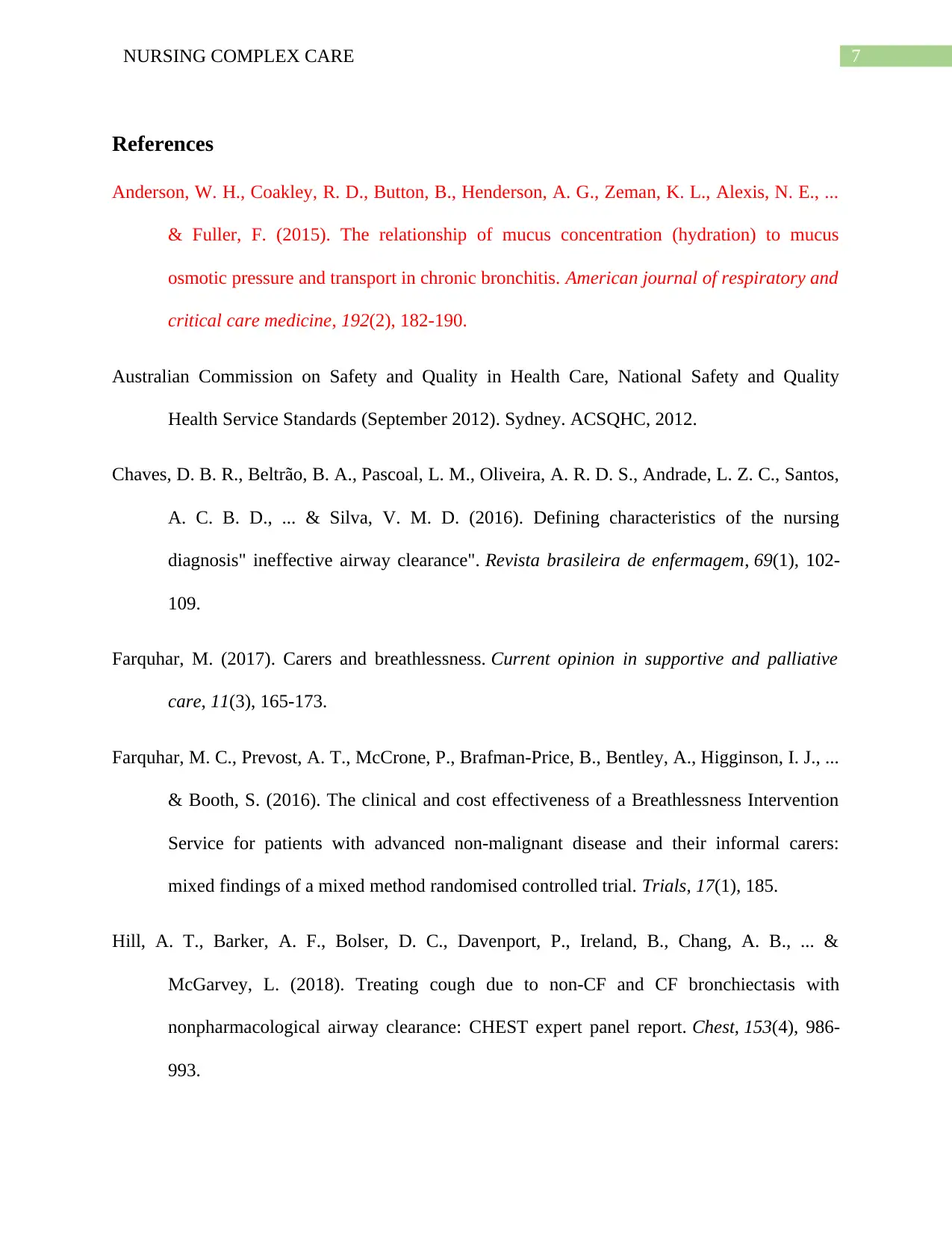
7NURSING COMPLEX CARE
References
Anderson, W. H., Coakley, R. D., Button, B., Henderson, A. G., Zeman, K. L., Alexis, N. E., ...
& Fuller, F. (2015). The relationship of mucus concentration (hydration) to mucus
osmotic pressure and transport in chronic bronchitis. American journal of respiratory and
critical care medicine, 192(2), 182-190.
Australian Commission on Safety and Quality in Health Care, National Safety and Quality
Health Service Standards (September 2012). Sydney. ACSQHC, 2012.
Chaves, D. B. R., Beltrão, B. A., Pascoal, L. M., Oliveira, A. R. D. S., Andrade, L. Z. C., Santos,
A. C. B. D., ... & Silva, V. M. D. (2016). Defining characteristics of the nursing
diagnosis" ineffective airway clearance". Revista brasileira de enfermagem, 69(1), 102-
109.
Farquhar, M. (2017). Carers and breathlessness. Current opinion in supportive and palliative
care, 11(3), 165-173.
Farquhar, M. C., Prevost, A. T., McCrone, P., Brafman-Price, B., Bentley, A., Higginson, I. J., ...
& Booth, S. (2016). The clinical and cost effectiveness of a Breathlessness Intervention
Service for patients with advanced non-malignant disease and their informal carers:
mixed findings of a mixed method randomised controlled trial. Trials, 17(1), 185.
Hill, A. T., Barker, A. F., Bolser, D. C., Davenport, P., Ireland, B., Chang, A. B., ... &
McGarvey, L. (2018). Treating cough due to non-CF and CF bronchiectasis with
nonpharmacological airway clearance: CHEST expert panel report. Chest, 153(4), 986-
993.
References
Anderson, W. H., Coakley, R. D., Button, B., Henderson, A. G., Zeman, K. L., Alexis, N. E., ...
& Fuller, F. (2015). The relationship of mucus concentration (hydration) to mucus
osmotic pressure and transport in chronic bronchitis. American journal of respiratory and
critical care medicine, 192(2), 182-190.
Australian Commission on Safety and Quality in Health Care, National Safety and Quality
Health Service Standards (September 2012). Sydney. ACSQHC, 2012.
Chaves, D. B. R., Beltrão, B. A., Pascoal, L. M., Oliveira, A. R. D. S., Andrade, L. Z. C., Santos,
A. C. B. D., ... & Silva, V. M. D. (2016). Defining characteristics of the nursing
diagnosis" ineffective airway clearance". Revista brasileira de enfermagem, 69(1), 102-
109.
Farquhar, M. (2017). Carers and breathlessness. Current opinion in supportive and palliative
care, 11(3), 165-173.
Farquhar, M. C., Prevost, A. T., McCrone, P., Brafman-Price, B., Bentley, A., Higginson, I. J., ...
& Booth, S. (2016). The clinical and cost effectiveness of a Breathlessness Intervention
Service for patients with advanced non-malignant disease and their informal carers:
mixed findings of a mixed method randomised controlled trial. Trials, 17(1), 185.
Hill, A. T., Barker, A. F., Bolser, D. C., Davenport, P., Ireland, B., Chang, A. B., ... &
McGarvey, L. (2018). Treating cough due to non-CF and CF bronchiectasis with
nonpharmacological airway clearance: CHEST expert panel report. Chest, 153(4), 986-
993.
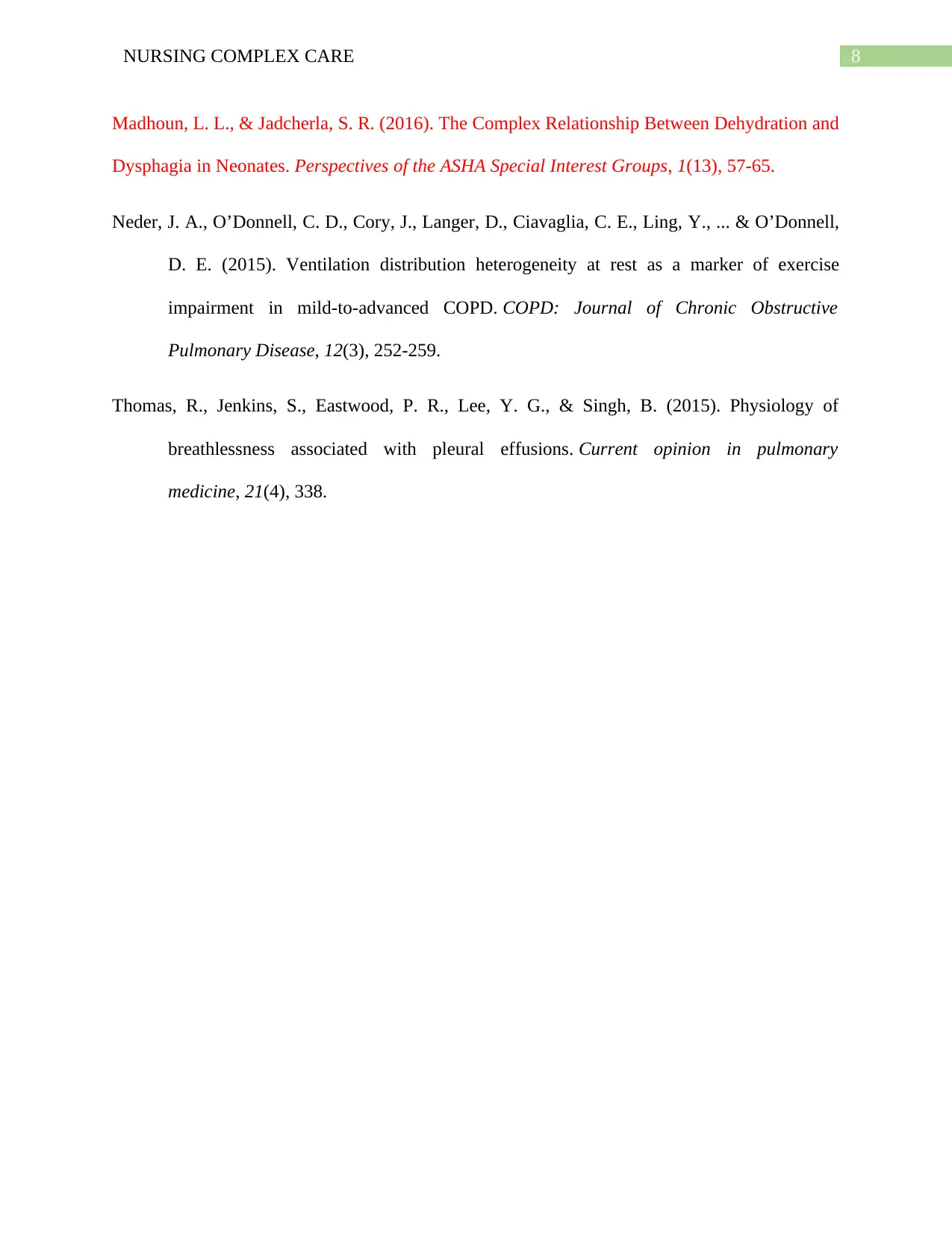
8NURSING COMPLEX CARE
Madhoun, L. L., & Jadcherla, S. R. (2016). The Complex Relationship Between Dehydration and
Dysphagia in Neonates. Perspectives of the ASHA Special Interest Groups, 1(13), 57-65.
Neder, J. A., O’Donnell, C. D., Cory, J., Langer, D., Ciavaglia, C. E., Ling, Y., ... & O’Donnell,
D. E. (2015). Ventilation distribution heterogeneity at rest as a marker of exercise
impairment in mild-to-advanced COPD. COPD: Journal of Chronic Obstructive
Pulmonary Disease, 12(3), 252-259.
Thomas, R., Jenkins, S., Eastwood, P. R., Lee, Y. G., & Singh, B. (2015). Physiology of
breathlessness associated with pleural effusions. Current opinion in pulmonary
medicine, 21(4), 338.
Madhoun, L. L., & Jadcherla, S. R. (2016). The Complex Relationship Between Dehydration and
Dysphagia in Neonates. Perspectives of the ASHA Special Interest Groups, 1(13), 57-65.
Neder, J. A., O’Donnell, C. D., Cory, J., Langer, D., Ciavaglia, C. E., Ling, Y., ... & O’Donnell,
D. E. (2015). Ventilation distribution heterogeneity at rest as a marker of exercise
impairment in mild-to-advanced COPD. COPD: Journal of Chronic Obstructive
Pulmonary Disease, 12(3), 252-259.
Thomas, R., Jenkins, S., Eastwood, P. R., Lee, Y. G., & Singh, B. (2015). Physiology of
breathlessness associated with pleural effusions. Current opinion in pulmonary
medicine, 21(4), 338.
⊘ This is a preview!⊘
Do you want full access?
Subscribe today to unlock all pages.

Trusted by 1+ million students worldwide
1 out of 9
Related Documents
Your All-in-One AI-Powered Toolkit for Academic Success.
+13062052269
info@desklib.com
Available 24*7 on WhatsApp / Email
![[object Object]](/_next/static/media/star-bottom.7253800d.svg)
Unlock your academic potential
Copyright © 2020–2025 A2Z Services. All Rights Reserved. Developed and managed by ZUCOL.





